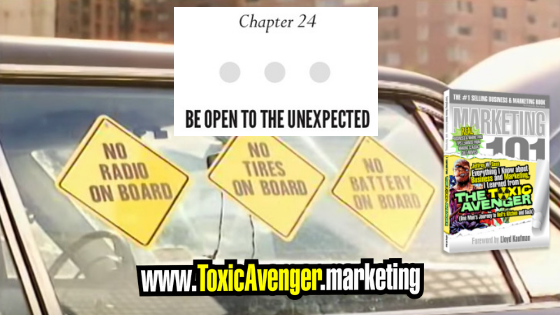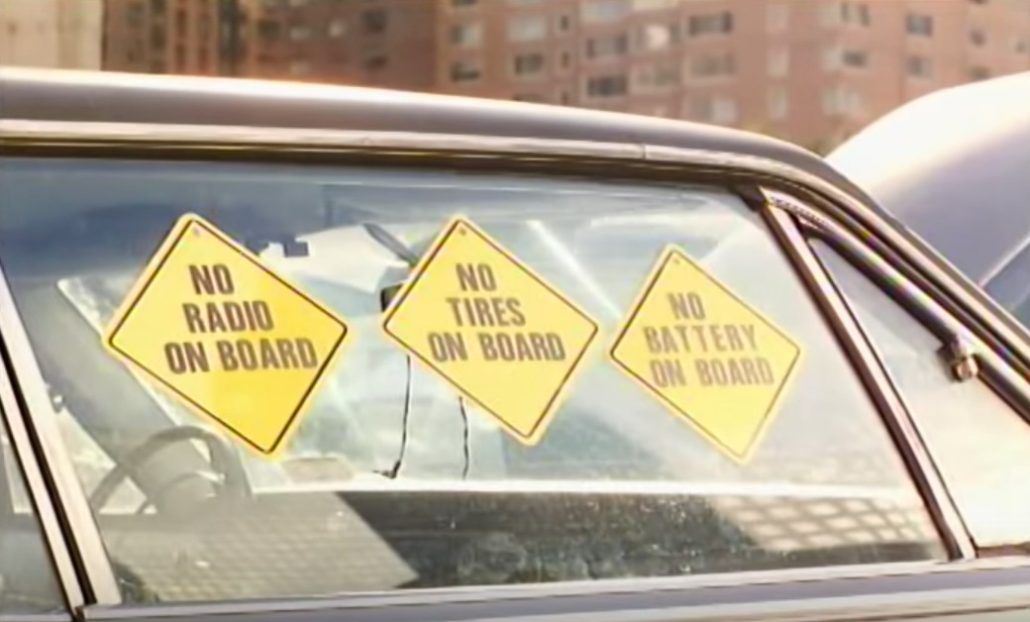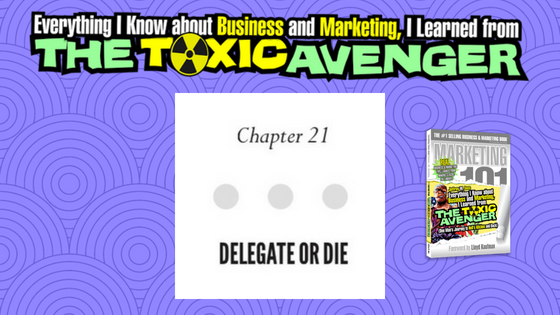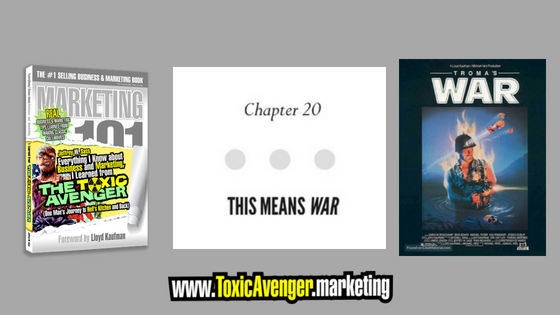Chapter 29: Raising your Hand
Greetings from Tromaville! Here is Chapter 29 of my book, Everything I Know about Business and Marketing, I Learned from THE TOXIC AVENGER. This chapter addresses stepping up to take on new opportunities, whether you are qualified or not…
If you haven’t done so already, you can read the Foreword by Troma co-founder, Lloyd Kaufman, and the Introduction to the book as well as Chapter 1, 2, 3, 4, 5 and 6, 7, 8, 9, 10, 11, 12, 13, 14, 15, 16, 17, 18, 19, 20, 21, 22, 23, 24, 25, 26, 27 and 28. You can also see me read a few chapters live, along with Lloyd and Toxie, at Florida Supercon as well as a few chapters I read on Facebook Live. Stay tuned for additional chapters to be published here. If you like what you read and can’t wait for more, please don’t be shy. You can buy the book now on Amazon (and also please don’t be shy about sharing, and reviewing the book when you do read it.) Both Toxie and I greatly appreciate your support! – Jeff Sass
Chapter 29: RAISING YOUR HAND
In business, there are many theories about doing things “in-house” versus
“outsourcing” or hiring agencies, consultants, so-called experts, and
other third parties to work on your company’s behalf. It is a decision
entrepreneurs struggle with all the time, and in truth, the decision is
based on much more than a cost-benefit analysis. There are other considerations, including your company culture, to think about when deciding what roles your employees play versus the roles of outsiders.
In Tromaville this decision was easier to make, as we didn’t have the
resources (or mind-set, for that matter) to hire someone from outside to
do the work someone inside could do cheaper (and, perhaps better, but
mainly cheaper). After all, when we were in production, we were known
for throwing inexperienced people into uncharted waters and hoping for
the best. Why wouldn’t the same philosophy apply when we operated the
business side of things? For the most part, it did.
When we were growing and making more deals, our legal bills were
growing as well, as we had to run everything by “outside counsel.” Instead
of continuing to pay the pros exorbitant fees, we hired a young, green
law school graduate who had probably spent far more time in a bar than
studying for and passing the Bar. He was eager to work, had no practical
experience yet, and thus was willing to work for very little in order to gain real-world experience as “in-house” counsel for an established independent
movie studio. (It sounds good on paper, doesn’t it?)
In truth, David G was a bright, eager, somewhat conservative addition
to the Troma Team. (You will note that in previous chapters I use people’s
actual names; however, in this case, I have chosen to say “David G” instead
of our lawyer’s real name. I ain’t stupid. He is a lawyer, after all…). In
truth, as with many who passed through Tromaville and passed their sink-or-swim test, David proved to be a genuinely talented attorney who may
have learned by fire at Troma, but also earned the respect of an industry
and went on to have a great career as a leading entertainment attorney.
Having a young, in-house attorney is something I learned from Troma
that I have lobbied for at every company I have worked at since, and I have
always hired one at every company I have founded and have been in control of. Sure, you still will need the expertise of out-house counsel from
time to time, but having someone on your payroll to do as much of the
legal legwork as possible, and then letting the high-priced pros review it,
will pay for itself in no time. Plus, an in-house legal beagle will truly and
fully understand the ins and outs of your business in ways “the big guys”
never will, and your inside guy or gal will create a sense of checks and
balances with the outside firm of record. It may seem frivolous for a small
start-up of ten or twelve employees to have an attorney on staff, but I can
assure you from experience it can be a tremendous benefit and cost savings in the long run.
Clearly, in Tromaville the culture was one of DIY at every possible turn,
which is how I suddenly found myself at the heart of the licensing and
merchandising industry. We were in the midst of launching The Toxic
Crusaders, the cartoon spin-off of The Toxic Avenger that was going to be
produced as a Saturday-morning cartoon series, made by the same animation studio, MWS, that had been responsible for the megasuccessful
animated TMNT: Teenage Mutant Ninja Turtles. The Turtles had emerged
from the shell of a popular underground comic to become one of the biggest TV, toy, and game phenomenon in history. Kids everywhere were
obsessed with the adventures of Michelangelo, Donatello, Leonardo, and
Raphael and a gazillion dollars were being spent on TMNT toys, games,
clothes, and anything capable of having a logo printed on it. The Teenage
Mutant Ninja Turtles were an industry, and at that moment it appeared that The Toxic Crusaders were ideally positioned to be next in line for the kids’ cartoon and merchandising throne.
Miraculously, Toxie was loved by the industry that had made the
Turtles massive. Like the TMNT, Toxie was edgy, action-packed, and had
an underlying positive message—pro-environment and anti–toxic waste.
(Toxie knew firsthand the perils of that!) We were shell-shocked by the
attention but managed to line up the animation deal with MWS (same as
TMNT) and a master toy license with Playmates Toys (same as TMNT).
We had the “A” team behind us and woke up every day pinching ourselves
to test the realization that kids everywhere would soon be looking up to
a hideously deformed creature of superhuman size and strength that first
gained notoriety in a trashy, uber-violent, R-rated, low-budget, low-brow
cult movie. The irony was not lost on anyone. The engine of greed salivating
for the next TMNT made it all OK.
So as the animated series commenced production and the Playmates toy line began taking its hideously deformed shape (in the form of neon green
Toxie action figures and accessories) we were suddenly the darlings
of an industry we knew nothing about. Suddenly we were being courted
by every major licensing agent in the industry, from Surge Licensing, the
team behind the TMNT merchandising machine generating hundreds of
millions of dollars in royalties, to a literal parade of agencies and agents
ascending our narrow stairs to enter Tromaville and trying to convince us
to sign over our exclusive rights for them to represent.
One guy literally showed up with a check for $50,000 that he insisted
we take as a deposit against the millions of dollars of royalty fees he would
soon be raining upon us. We didn’t have an agreement or contract with
him. He just handed us a check. Lloyd held it, briefly, until Michael
promptly swiped it from him, and inspected it carefully. $50,000 was
a lot of dough in Tromaville in those days. We made entire movies for
$50,000. And this guy was ready to hand it over to us, over a property he
barely knew anything about. I suppose Gordon Gekko was right: “Greed is good.” Thanks to the Teenage Mutant Ninja Turtles, when people in the
licensing industry looked at Toxie, they did not see his grossly wrinkled
skin or droopily deformed eye. All they saw was green. And not the green
of his toxically tanned skin, but rather the green of money. The whole thing made us, the proud purveyors of so-called schlock, feel a bit “icky.”
After the wave of eager agents had subsided and we were able to
reflect on our newfound role as the apparent object of everyone’s affection,
we realized that all of our suitors had one thing in common. They all
wanted to keep one-third of all the money we would make from The Toxic
Crusaders. That seemed to be the industry standard. They’d go out and
make licensing deals with the manufacturers of sneakers and bedsheets
and pajamas and school supplies and underwear and coloring books and
anything and everything else they could, and in return, they’d keep a full
33.33 percent of what we collected from such deals. From where we sat
that was a pretty steep commission.
So I raised my hand.
“How hard can this be?” I asked Lloyd and Michael. “I mean, it’s not rocket
science, and we already have all the manufacturers interested in The Toxic
Crusaders thanks to the TV series and Playmates Toys. Why should we give
up a third? I’ll do it.”
And with that, Troma Licensing was formed, and I was it.
It was dive in headfirst and sink or swim. I was, fortunately, able to
swim and soon became entrenched in the world of licensing and merchandising.
In truth, it is an amazing industry, at the time led by many sincere
and hardworking manufacturers that were often long-standing family
businesses, like Wormser Pajamas. As a kid, I wore Batman pajamas
made by Wormser, so it was truly a thrill to get to know and work with
Ed Wormser and his team to make Toxic Crusaders PJs. And it seemed
everyone in the close-knit industry was warm, friendly, and eager to see
Toxie succeed. I was very glad I raised my hand.
When new opportunities arise for your business before you hire the so-called experts, could you create an expert from within?
• • •
That’s Chapter 29 – In business, especially in a startup, it can be advantageous to keep it “in-house” and do it yourself when a new opportunity arises. Could someone on your team do it just as well as an outside expert?Stay tuned for Chapter 30: “In What Universe Could The Toxic Avenger and Reading Rainbow Coexist? The Troma Universe” which goes behind the scenes of one of the most unlikely partnerships in entertainment history!
The book in previous posts:
Foreword, by Lloyd Kaufman
Introduction: Lights, Camera, Action!
Chapter 1: Welcome to Tromaville!
Chapter 2: The Troma Building
Chapter 3: Meet the Moguls
Chapter 4: Trailer Trash
Chapters 5 and 6: Working FREE-lance & Becoming a Full-time Tromite
Chapter 7: Branding Begins on the Ground Floor
Chapter 8: The Power of We
Chapter 9: Old Yeller (and Be Your Brand)
Chapter 10: Find Something to Believe In
Chapter 11: Show Up!
Chapter 12: Sink or Swim!
Chapter 13: Embrace your Vision and Culture!
Chapter 14: Strategic Partners – Burn Houses, Not Bridges
Chapter 15: If You Don’t Want to Swallow a Frog, Start with a Stunt
Chapter 16: Repurpose, On Purpose!
Chapter 17: Always Salute the Schwag!
Chapter 18: Playing by the Rules
Chapter 19: Fix it, or Forget it… Fast!
Chapter 20: This Means WAR!
Chapter 21: Delegate or Die!
Chapter 22: Location, Location, Location
Chapter 23: Everyone is Expendable (Especially if you Wear a Mask!)
Chapter 24: Be Open to the Unexpected
Chapter 25: Influencing the Influencers
Chapter 26: Yes, we Cannes!
Chapter 27: Putting Out Fires (Literally!)
Chapter 28: Sleeping on the Job!









